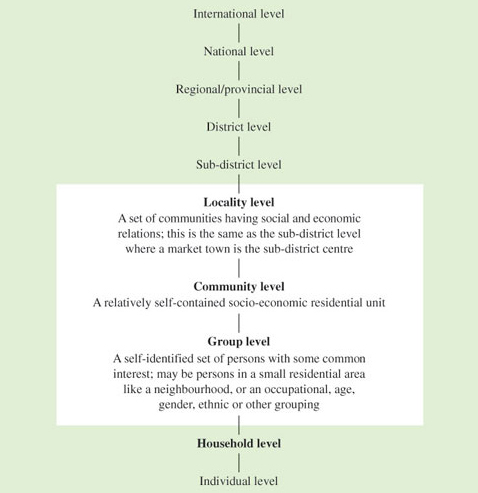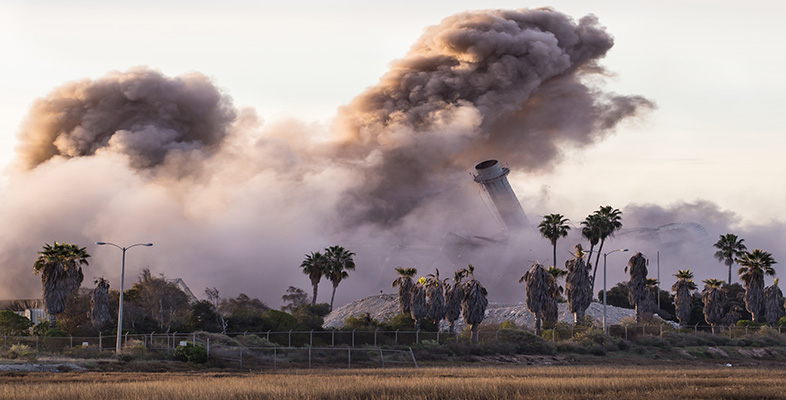4.2 Different levels of decision making
We make decisions and take actions at a range of different levels: on our own, and within families, communities, nations and international regions. The concept of levels can be useful in working out where decisions are made or should be made.
An example is provided by Norman Uphoff (1992) when considering the types of local institution involved in development activity. See Figure 4.

The unshaded area in Uphoff’s diagram communicates what he means by local institutions. He has drawn conceptual boundaries around ten different levels where decision making and action can occur, ranging from individual to international. By naming and describing the levels he can communicate his understanding to others. He also challenges the way many people use the word local by constructing a boundary around three of the levels – the locality, community and group levels. The distinction is important because, for example, the involvement of local-level institutions is recognised (by Uphoff and others) as essential for mobilising resources and helping to resolve resource management conflicts. Involving just one of the three local levels for decision making may well mean that opportunities to reach a wider constituency are missed. Since this diagram was developed, others (e.g. Buckingham-Hatfield and Percy, 1999) have come forward with even wider understandings of localism. So reaching people at the local level clearly has different meaning for different people.
Uphoff’s diagram is being presented here out of context. He went on to give much more descriptive detail and examples of what he meant by the levels in his diagram. He had a particular perspective in that he was writing about local institutions and participation for sustainable development and considering the roles of different organisations and institutions and their effectiveness for natural resource management. The diagram is not necessarily appropriate for all organisations and institutions, particularly where they operate at many different levels. For example, it would be difficult to place a self-identified group of people with some common interest from within one organisation which had several sites (though care is needed in ascribing a perspective to a group as there is likely to be variation within it). Individuals might in that case come from different geographical locations. The group might be predominantly ‘local’ but the organisation ‘regional’ or ‘national’. However, diagrams can be useful in different ways and Uphoff’s diagram is a valuable prompt for considering different levels of environmental decision making.
Activity 17 Exploring levels of environmental decision making
Use Uphoff’s diagram in Figure 4 as a prompt to explore your own understanding of levels of environmental decision making, particularly at a local level.
- (a) Write down some examples of levels at which you are an active environmental decision maker.
- (b) Do you identify with any levels of decision making that are not represented on Uphoff’s diagram? If so, briefly describe them.
- (c) Consider your ‘local-level’ environmental decision making in more detail. In which local institutions are you involved in environmental decision making? Do they correspond to Uphoff’s ‘group’, ‘community’ and ‘locality’ levels? If not, how would you group them?
- (d) In what contexts and at what levels would you like to be more active in environmental decision making?
Discussion
- (a) My own levels of environmental decision making are individual, household and group level (as a committee member of a local charity), community level (with others from the group of houses at our end of the village), regional level (as a member of a local Nature Conservation Trust which draws its membership from several districts) and national level (as a member of a national environmental and development committee making policy decisions).
- (b) I have worked on a couple of European environmental projects in the past few years, funded by the European Union, so I identify with a regional level that is between the international and national levels as well as the regional level between national and district level. This kind of regional level is not represented on Uphoff’s diagram. As his work was trying to emphasise the local level, I assume he has just included that level within the grouping of ‘international level’. It is indeed international but still identifies with a specific region.
- (c) I can identify with the group and community levels easily enough. At group level, for example, I attend a local evening class where there is a certain amount of group decision making overuse of materials, which is one environmental dimension. I am also on the committee of a local charity where we make many decisions about our use of resources, including transport and equipment. At community level, the people at our end of the village have collectively organised ourselves on occasion to take part in planning decisions. I cannot think of anything I am involved in at Uphoff’s ‘locality level’ although I can think of an activity in which people from several communities are involved. I am a little unsure whether this would be a sub-district level activity, though, so I would need to read what Uphoff intended for each level to be sure. From my own direct experience I would only have identified two ‘local’ levels, so I have found Uphoff’s diagram useful to make me think about other possible groupings.
- (d) I have seen the area in which I live come under increasing pressure from road and housing development. I always feel I end up complaining after the event because I missed the opportunity to get involved at an earlier stage and to contribute more constructively. So I would like to be more involved at community and perhaps locality levels of decision making.
One final point on levels before we leave this section. There is a difference between the level at which we make decisions and the level at which the effects of our decisions are evident. For example, our local decisions to purchase timber products or burn fossil fuels may have an impact at several different levels, from local to global.
